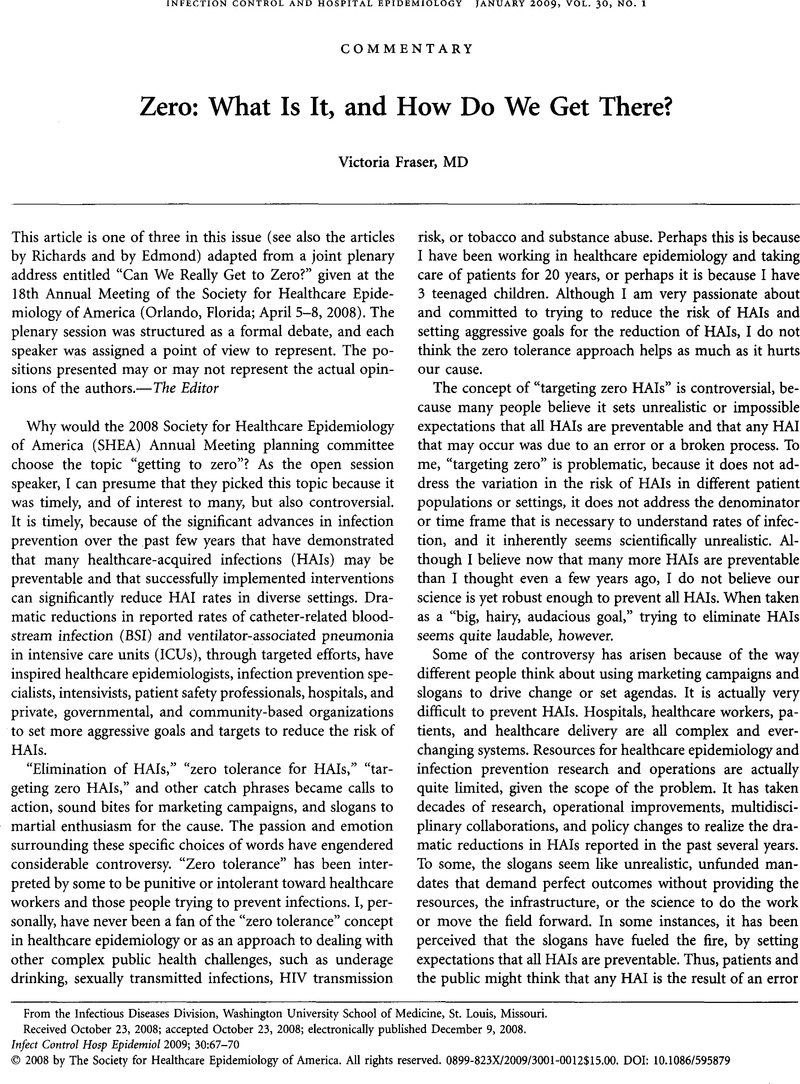Article contents
Zero: What Is It, and How Do We Get There?
Published online by Cambridge University Press: 02 January 2015
Abstract
An abstract is not available for this content so a preview has been provided. Please use the Get access link above for information on how to access this content.

- Type
- Commentaries
- Information
- Copyright
- Copyright © The Society for Healthcare Epidemiology of America 2009
References
1.Eickhoff, TC. General comments on the Study on the Efficacy of Nosocomial Infection Control (SENIC Project). Am J Epidemiol 1980;111:465–469.Google Scholar
2.Haley, RW, Quade, D, Freeman, HE, Bennett, JV. The SENIC Project: Study on the Efficacy of Nosocomial Infection Control (SENIC Project): summary of study design. Am J Epidemiol 1980;111:472–485.CrossRefGoogle Scholar
3.National Nosocomial Surveillance System. National Nosocomial Infections Surveillance (NNIS) System Report, data summary from January 1992 through June 2004, issued October 2004. Am J Infect Control 2004;32:470–485.Google Scholar
4.Kohn, L, Corrigan, J, Donaldson, M, eds. To Err is Human: Building a Safer Health System. Washington, D.C.: National Academy Press; 2000.Google Scholar
5.Edwards, JR, Peterson, KD, Andrus, ML, et al. National Healthcare Safety Network (NHSN) Report, data summary for 2006, issued June 2007. Am J Infect Control 2007;35:290–301.CrossRefGoogle ScholarPubMed
6.Babcock, HM, Zack, JE, Garrison, T, et al. An educational intervention to reduce ventilator-associated pneumonia in an integrated health system: a comparison of effects. Chest 2004;125:2224–2231.Google Scholar
7.Coopersmith, CM, Zack, JE, Ward, MR, et al. The impact of bedside behavior on catheter-related bacteremia in the intensive care unit. Arch Surg 2004;139:131–136.Google Scholar
8.Warren, DK, Zack, JE, Mayfield, JL, et al. The effect of an education program on the incidence of central venous catheter-associated bloodstream infection in a medical ICU. Chest 2004;126:1612–1618.CrossRefGoogle Scholar
9.Warren, DK, Zack, JE, Cox, MJ, Cohen, MM, Fraser, VJ. An educational intervention to prevent catheter-associated bloodstream infections in a nonteaching, community medical center. Critical Care Medicine 2003;31:1959–1963.Google Scholar
10. Institute for Healthcare Improvement. Overview of the 100,000 Lives Campaign. Available at: http://www.ihi.org/IHI/Programs/Campaign/100kCampaignOverviewArchive.htm. Accessed October 15, 2008.Google Scholar
11. Pittsburgh Regional Health Initiative. Available at: http://www.prhi.org/. Accessed October 16, 2008.Google Scholar
12.Pronovost, P, Needham, D, Berenholtz, S, et al. An intervention to decrease catheter-related bloodstream infections in the ICU. N Engl J Med 2006;355:2725–2732.CrossRefGoogle ScholarPubMed
13.Apisarnthanarak, A, Pinitchai, U, Thongphubeth, K, et al. Effectiveness of an educational program to reduce ventilator-associated pneumonia in a tertiary care center in Thailand: a 4-year study. Clin Infect Dis 2007;45:704–711.CrossRefGoogle Scholar
14.Bleasdale, SC, Trick, WE, Gonzalez, IM, Lyles, RD, Hayden, MK, Weinstein, RA. Effectiveness of chlorhexidine bathing to reduce catheter-associated bloodstream infections in medical intensive care unit patients. Arch Intern Med 2007;167:2073–2079.CrossRefGoogle ScholarPubMed
15.Collins, J. Good to great: why some companies make the leap—and others don't. 1st ed. New York, NY: Harper Business; 2001.Google Scholar
16.Zell, BL, Goldmann, DA. Healthcare-associated infection and antimicrobial resistance: moving beyond description to prevention. Infect Control Hosp Epidemiol 2007;28:261–264.CrossRefGoogle ScholarPubMed
17.Klevens, RM, Edwards, JR, Richards, CL Jret al. Estimating health care-associated infections and deaths in U.S. hospitals, 2002. Public Health Rep 2007;122:160–166.Google Scholar
- 2
- Cited by


